#educational environment
Explore tagged Tumblr posts
Text
0 notes
Text
Aplus Wisdom
Software plays a crucial role in schools by enhancing both learning and administrative processes. Educational software supports teaching through interactive learning tools, personalized assignments, and progress tracking. School management software, like APlusWisdom, streamlines administration by managing student data, assignments, and communication between parents, teachers, and students. It also enables real-time tracking of student performance and transparent communication, fostering a connected learning environment.
For more information, you can visit APlusWisdom's website.
#school management system#educational environment#school management software#school management system software
0 notes
Text
youtube
Watch the 2024 American Climate Leadership Awards for High School Students now: https://youtu.be/5C-bb9PoRLc
The recording is now available on ecoAmerica's YouTube channel for viewers to be inspired by student climate leaders! Join Aishah-Nyeta Brown & Jerome Foster II and be inspired by student climate leaders as we recognize the High School Student finalists. Watch now to find out which student received the $25,000 grand prize and top recognition!
#ACLA24#ACLA24HighSchoolStudents#youtube#youtube video#climate leaders#climate solutions#climate action#climate and environment#climate#climate change#climate and health#climate blog#climate justice#climate news#weather and climate#environmental news#environment#environmental awareness#environment and health#environmental#environmental issues#environmental education#environmental justice#environmental protection#environmental health#high school students#high school#youth#youth of america#school
23K notes
·
View notes
Text
Creating Safe and Engaging Daycare Interiors for Young Learners
Designing a daycare interior that is both safe and engaging can be no small task. Being a daycare owner or designer, one understands the importance of creating an area where small children will be able to explore, learn, and grow without compromising their safety. This blog will analyze the critical aspects of designing daycare interiors with protection and inspiration for young minds. From the…
#adaptable interiors#Child Safety#child-friendly spaces#childcare spaces#Color Psychology#Creative Learning#daycare interiors#educational environment#engaging environment#interactive spaces#Play-Based Learning#Playful Environment#safe design#sensory experiences#young learners
0 notes
Text
It's punk to compost, in a world filled with trash.
It's punk to be fat, in a world that wants you to keep getting smaller.
It's punk to ride an old bike, drive an old car, patch your old clothes with different colored thread, cut up old sheets for rags instead of using paper towels, and make stuffed animals out of scrap fabric, in a world that wants you to just "order it off amazon".
It's punk to tend a messy, overgrown, weed-filled garden. Tomatoes grow right next to dandelions.
It's punk to can the veggies from your messy garden and give your neighbors delicious tomato soup in the depths of winter.
It's punk to make a bird feeder and look out the window to take a break from your screen.
It's punk to wear your "Let Trans Kids Play" shirt to a college basketball game where there are no trans players, because a trans kid in the crowd will see it and maybe (this year) decide to join the team.
It's punk to have wrinkles, when the world wants you to stop aging at 23.
It's punk to go to your local library.
It's punk to take your kids to your local library.
It's punk to take your kids to a pride parade, a sit-in, a land-back ceremony, an accessible trunk-or-treat, a soup kitchen.
It's punk to plant trees. It's punk to PROTECT trees.
It's punk save for solar panels, someday.
It's punk to hope, whenever you can.
3K notes
·
View notes
Text
*tries to organize my thoughts*
*remembers i'm not in school and therefore beholden to neither heaven nor hell nor any man's grading system*
*joyously shredding & tossing all my carefully arranged 3x5 mental notecards into the air like so much beige confetti. raising my arms in victory, cheering raucously until i accidentally inhale bits of homemade confetti*
(*coughing up itty bits of paper like a cat evicting a hairball with a firm understanding of tenants' rights*) wait wat happens next
#i marie kondoed my thoughts and *i* feel great. but now my stream-of-consciousness has escaped containment#so many innocent bystanders at stake#every time i try to organize my thoughts i run out of plastic bins and have to make a trip to the container store where i get even more dis#racted so. you can't just hand me THIS brain and NO catalogue OR library classification system#and expect me to single-handedly sort through all this nonsense? bad form but fucking form not in my job description#aNYways. formal education sure did a FUCKING NUMBER on us huh#(a number i measure not in gpa or dollars of student debt.#but in the number of therapy sessions & medical debt it will take to recover.)#seriously folks. our education systems are...innately traumatizing for a huge number of students. and we NEED to address this.#the fact that it is culturally common for adults to have anxiety nightmares about school/exams...even decades later?#that is not cute. it is Alarming.#no one--much less entire generations--should be spending their developmental years in an environment of chronic stress & pressure & strain#and yet that is the reality for millions and millions of pre-teen and teenage and young adult students#this isn't healthy and it serves and empowers NO ONE#...except of course the many exploitative educational & financial & debt-collecting institutions thriving from the current balance of power#and of course it's a nefarious and powerful way to sabotage/erase the middle class#which billionaires and the wealth-inequality creators they finance couldn't possibly have any noteworthy interest in whatsoever#it's not like there's an elite group of people with huge financial incentives to drain/steal resources from the masses...#anyways sorry for going all Conspiracy Theory on you.#obviously the billionaires who control the vast majority of our resources and news and political campaign funding#are not tied to every single itty bitty social issue and i'm a silly billy to imply it#please tell elon musk to ignore this tweet i am so subservient and acquiescent#mr musky u r so good at inheriting slavery-built mining fortunes & buying other people's companies#& building rocket ships & fancy cars that do NOT explode/catch fire & also NOT running billion dollar companies into the ground#mr musky u r so talented genius billionaire playboy with 10 kids and ex-wives who find you creepy af babe u r basically iron man
2K notes
·
View notes
Text
i'm kind of late to this but i just finished reading the scholomance trilogy by naomi novik and i feel like it is such an underrated urban fantasy?? taking the chosen one trope and turning it on its head with a fmc who has been prophesied to bring death and destruction, who is imbued with terrible power, but cannot even properly use said power to solve any of her obstacles because it would obliterate them and her soul. it takes a tired trope and the idea of an 'overpowered mary sue' and throws it back in your face by showing how all the power and destiny in the world is useless against a system filled with corruption that has burdened you with an easy way out (evil/destructive magic) that you can't take so now you have to work twice as hard as everyone else just to do simple, constructive spells instead of flicking your wrist and being done with it.
#the scholomance#naomi novik#galadriel higgins#orion lake#bookblr#urban fantasy#a deadly education#the last graduate#ya fantasy#the golden enclave#ya fiction#it has a diverse cast#queerness just effortlessly woven in#and the entire thing is so seamlessly crafted with a narrative on what real change looks like#how to really rid your environment of corruption and change society for the better you have to do the gritty work#you have to be willing to do the unpleasant hard grueling organization and working with people / meeting them where they're at#you might not even get to see or do the pretty parts#but its still worth doing the distatesful shit#doing the compromising and giving space for people to learn and make up for mistakes#so that future generations can do better#and have the childhood u didn't#no spoilers in case by some miracle i convince another soul to read this but like#she legit fucking says it in the book#it's not the work she wants to do in the end. not what she envisioned. but she does what she must to make sure other kids don't suffer#makes me think of climate activism so much#we might not get to have the pretty wonderful utopia but we have to be willing to do the shitty stuff it takes to make that future possible
209 notes
·
View notes
Text


Timeskip fukutoras
#i took an environment drawing class this summer look at me using my education for good#portfolio building is for chumps im gonna waste my time obsessing over a single rarepair instead#half of these are them cooking i think i was hungry or something#kenma making a brief appearance to be homophobic as always#fukunaga's cooking generic green mush mmmm mush#you can tell these are older cause i don't give tora's hair the little curly loops#yamamoto taketora#fukunaga shouhei#fukutora#haikyuu#haikyuu!!#haikyuu fanart#hq#hq fanart#my art
188 notes
·
View notes
Text
I Got Fired for My Disability, and It’s Not Right
Hey everyone,
I’m writing this with a heavy heart, but I feel like I owe it to all of you to share what’s been going on. Recently, I was fired from my new job because of my learning disability. It hit me like a ton of bricks when my boss told me that if she had known about my disability during the interview, she wouldn’t have hired me. That’s not just unethical—it’s illegal.
For weeks, I struggled in a toxic environment where I was constantly yelled at for not learning fast enough, despite doing my best every day. I couldn’t eat. I couldn’t sleep. The stress was taking a toll on my mental and physical health. I wasn’t just trying to keep up with the fast pace; I was also fighting to prove that my disability doesn’t define me.
But now, I’m relieved to say I don’t have to endure that suffering anymore. As hard as it was, getting fired may have been a blessing in disguise. No one should have to work in an environment where they’re made to feel worthless for something they can’t control.
I’m honestly at a crossroads now. I’ve been treated like this so many times for being disabled, and it makes me wonder if it’s time to put everything into Cosmic Funnies. Maybe this is a sign to take the leap and turn it into my full-time job. I’ve been passionate about making astronomy fun and accessible for everyone, and it feels like a space where I’m appreciated for my creativity, not punished for how I learn.
I don’t have all the answers right now, and I’m not sure what’s next. But I wanted to be transparent with you, my community, because your support has always meant the world to me.
Thank you for being here with me during this difficult time. I’m hoping better days are ahead.
Take care,
Jacqueline
#cosmic funnies#astronomy#space#cute#science#kawaii#reblog#blog update#stars#educational#wrongfully fired#learning disability#toxic environment
142 notes
·
View notes
Note
Hey what autistic headcanons do you have for Johnny? (That’s so poorly worded but hopefully you know what I mean mb 😭)
Don't worry I totally understand!! Here's some doodles I made for it:
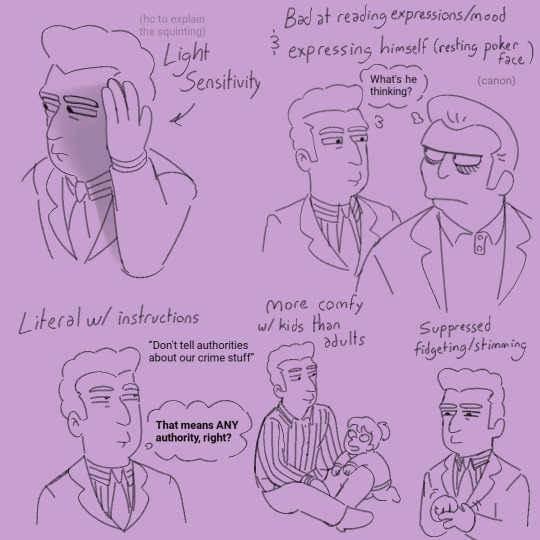
And also a comic of Johnny's initiation into the mafia:
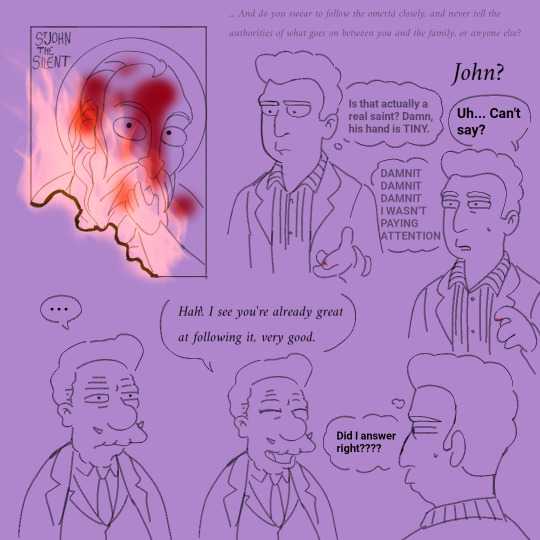
(Based on some quick research I did on how it goes. I can't believe saint JOHN the SILENT is a real christian saint.......)
I think Johnny might be a little emotionally constipated and insecure due to (COUGHS LOUDLY) a troubling past and isn't exactly comfortable with expressing interests or unserious behavior or performing odd habits, and his autism would interact VERY strongly with his social anxiety. He's gotten a bit better about it over the years as he becomes more familiar with his mob and especially with the Paxil prescription but learned habits for the sake of self-preservation are a hard thing to kick, you know?
#art#the simpsons#simpsons fanart#the simpsons fanart#johnny tightlips#jonathan schmallippe#giovanni silencio#simpsons fat tony#don Vittorio DiMaggio#autism headcanon#Johnny would be more outwardly autistic in the swap AU not only because of the less dangerous environment#but because he didn't have it AS ROUGH as he would have had it in canon. and he would've needed to interact with normal people more#to get his degree in education#I actually edited his wiki for an hour and half earlier today so I'm refreshed with a good understanding of his character
56 notes
·
View notes
Text
Hi guys! I'm here to tell you about some of the stuff Project 2025 would do to America.
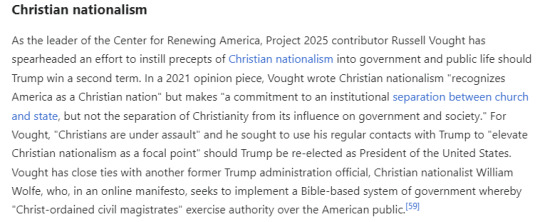
Number One: Making America a Christian Nation. What this means is the separation of church and state would be gone, and Trump will implement a "Bible-based system of government". Practicing other religions could be banned.

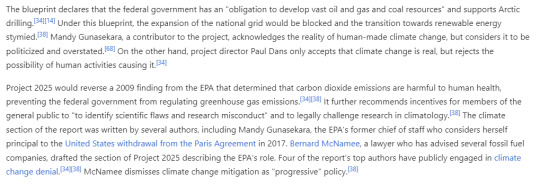
Number Two: Climate Change. Project 2025 will be completely removing most of the nation's regulations to help our environment. Abandoning ways to reduce greenhouse gases, abolishing the National Oceanic and Atmospheric Administration, relaxing regulations on fossil fuels, encouraging fossil fuel usage, and supporting arctic drilling.
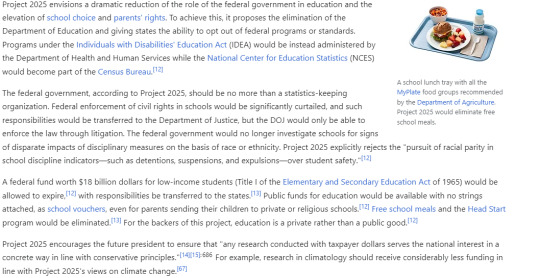
Number 3: Letting states control education. No more nationwide education, every state chooses what it wants to do. Possibility of removing accommodation plans for students who need it, no more free school meals even for free and reduced lunch plans, and the quote "Education is a private rather than a public good."
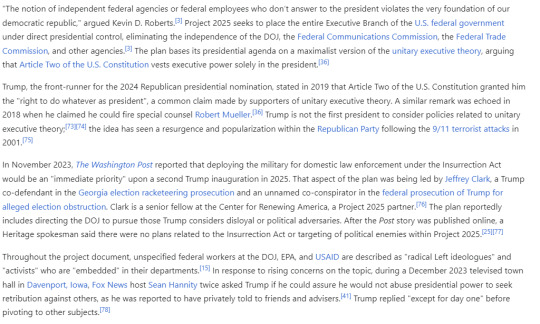
Number 4: Giving the president more power. The branches of government are supposed to balance each other out, make sure no one branch gets too powerful. This will make that a lot harder.
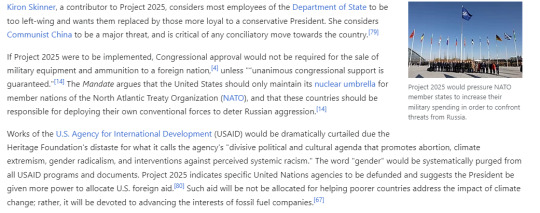
Number 5: Foreign Affairs. Congressional approval would not be required for the sale of military equipment and ammunition to a foreign nation. Also "The word gender would be systematically purged from all USAID programs and documents"???? "Such aid will not be allocated for helping poorer countries address the impact of climate change; rather, it will be devoted to advancing the interests of fossil fuel companies"????

Number 6: Healthcare. Removing Medicare's ability to negotiate medicine prices, denying gender-affirming care to trans people, forcing people to have a nuclear family basically.
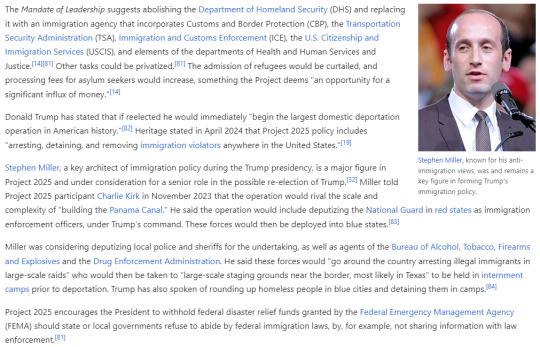
Number 7: All of this bullshit. It's all shit, but please take a look at the last sentence of paragraph 4: "Trump has also spoken of rounding up homeless people in blue cities and detaining them in camps."

Number 8: LGBTQ community. "Proposes the recognition of only heterosexual men and women, the removal of protection against discrimination on the basis of sexual or gender identity, and the elimination of provisions pertaining to diversity, equity, and inclusion (DEI) from federal legislation." "The goal here is to move toward colorblindness and to recognize that we need to have laws and policies that treat people like full human beings not reducible to categories, especially when it comes to race." THEN LET US BE WHO WE ARE. THIS IS THE OPPOSITE DIRECTION OF WHAT YOU ARE SAYING.

Number 9: Banning pornography. Just let people be people. We have needs. Let us be. Especially when Trump had that sneaky link that led him being charged on 34 counts.

Number 10: Abortion. Are we really going to let white males who don't know where the clitoris is decide what Women get to do with their bodies? You said in the pornography thing that it leads to the exploration of women, but isn't this doing the exact same thing?
In conclusion, Project 2025 would take away numerous rights that we deserve as human beings, including, but not limited to, having a clean environment, the right to an education, access to necessary medication, freedom of expression, sexual media, women's choice with their own bodies, and possibly freedom of religion, one of America's first amendment rights.
I'm scared. I am a queer minor with school accommodations, who has no way out of America.
I don't want to flunk out of high school because my accommodations got taken away from me.
I don't want to have a child at all, let alone before I turn 18 because I got raped and can't get an abortion because of what the government says I can and can't do with my body.
I don't want to be trapped in an area where I can barely breathe because of all the pollutants in the air.
I don't want to be discriminated against, harassed, or dehumanized because of my gender identity and sexuality.
I don't want to be forced to be a Christian.
I'm scared of my own country, and what it could do to me. I don't want to die.
Vote Blue. Or else America could be turned into a suppressive dictatorship.
Note: I will be unpinning this because there have been a lot of comments that make me think I may have said some things wrong in this post. I don't want to completely remove it, because a lot of people have reblogged it to spread information, but I will be removing it from my pin.
#project 2025#election 2024#american politics#us elections#2024 elections#vote blue no matter who#lgbt rights#queer rights#gay rights#education#abortion#environment#enviormentalism#religion#long post#rant#sort of#im scared#america#fuck america#fuck trump#fuck everything#i dont want to die#not like this
158 notes
·
View notes
Text

I am officially taking preorders for signed copies of The Everyday Naturalist: How to Identify Animals, Plants, and Fungi Wherever You Go! Due for release from Ten Speed Press on June 17, 2025, this is the book for people who love nature and want to know more about the living beings around them no matter where they are! Whether you're a birdwatcher getting to know your local feathered friends, a mushroom hunter wanting to get better at differentiating between edible and poisonous look-alikes, or some who's simply overwhelmed by your local plant diversity, this book is for you! You'll learn what traits to observe on any animal, plant, or mushroom you meet, and how to use that information with tools like field guides to identify what species you found. No experience needed--this book is for everyday naturalists around the world!
You can reserve your very own signed copy of The Everyday Naturalist from the author (me!) at TheEverydayNaturalist.com, to be sent out after the official release date next June.
#nature#wildlife#animals#plants#fungi#nature identification#ecology#books#nonfiction#writers#authors#science#scicomm#environment#educational#knowledge#naturecore#The Everyday Naturalist#naturalist
53 notes
·
View notes
Text
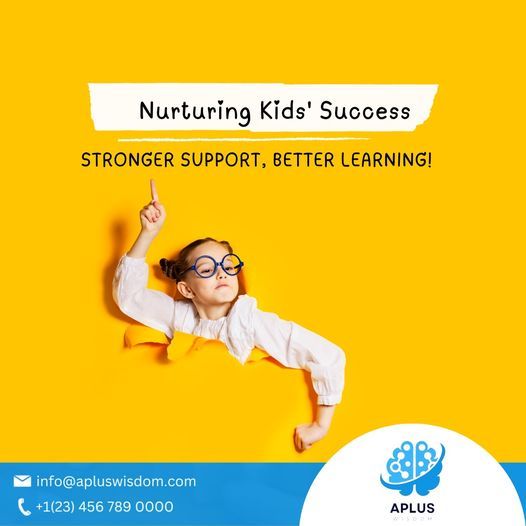
Discover Aplus Wisdom's premier school management software in Chicago, offering the best school management system solutions for seamless administration.
#school management system#school#school management software#educational environment#school management system software
0 notes
Text
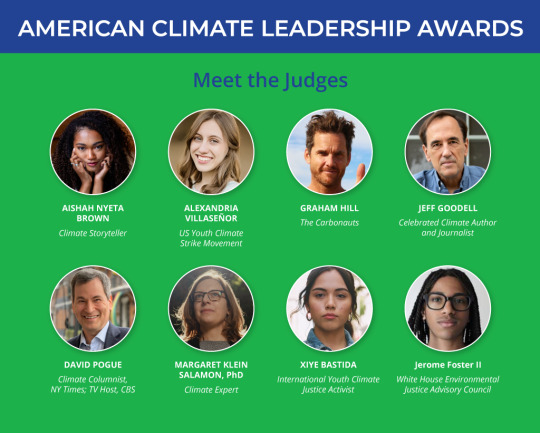
Apply or nominate: https://ecoamerica.org/american-climate-leadership-awards-2025/
Calling all organizations, individuals, and small businesses successfully engaging Americans on climate! Showcase your creativity and climate solutions by applying for @ecoamerica’s 2025 American Climate Leadership Awards. You can win $1K - $50K by submitting your efforts for consideration by a stellar line-up of judges and individuals leading on climate. It’s quick and easy to submit your application or nominate inspirational climate leaders. Apply or nominate today!
#ACLA25#ACLA25Leaders#ACLA25Youth#climate leaders#climate solutions#climate action#climate and environment#climate#climate change#climate and health#climate blog#climate justice#climate and education#climate news#weather and climate#environmental news#environment#environmental awareness#environmental education#environment and health#environmental#environmental issues#environmental impact#environmental justice#environmental protection#environmental health#high school students#high school#youth#awards
17K notes
·
View notes
Text
How to start a conversation with your first friend
(Eito Aotsuki Edition)
"What's your hobby? What food do you dislike? What's your star sign? What's your favorite manga? Which club are you in? Do you often watch movies? Do you play games? What do your parents do?"

#Eito Aotsuki#the hundred line#Eito spent most of his time in the hospital (?) so he focused on asking questions about things Takumi did in his free time#Knowing about the food Takumi dislikes can help him avoid awkward when inviting to eat together in the future#Asking about star sign is a good way to avoid asking directly about Takumi's birthday#also he can analyze a little more basic information based on the star sign#Asking about parents' occupations shows interest in family relationships + educational environment#anyway i'm just joking around you can see this as ramble
46 notes
·
View notes